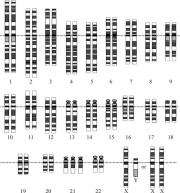December 2, 2009 weblog
Down Syndrome becoming more prevalent in the U.S.

(PhysOrg.com) -- A new study, aimed at estimating the prevalence of Down Syndrome in newborns, children and teenagers in 10 areas of the U.S., has found an increase in prevalence of more than 30 percent over the last 24 years.
Down syndrome is a condition in which the person has an extra chromosome 21, and is often associated with mental retardation and other problems such as heart abnormalities.
The major part of the study, by Dr Mikyong Shin and colleagues, was a cross-sectional analysis of live births from 1979 to 2003. The researchers analyzed data from 10 population-based registries of birth defects in 10 regions of the U.S., along with data for children from 0 to 19 years old, and calculated the prevalence of Down Syndrome for newborns, children and teenagers in each of the areas and in the total pool.
The data were also analyzed for the prevalence of Down Syndrome in specific age groups, for each gender, for different ethnic and racial groups, and for association with heart defects.
The researchers found an increase in prevalence of Down Syndrome at birth over the period from 9.0 to 11.8 per 10,000 live births, which represents an increase of 31.1%. The pooled data of 0-19-year-olds also indicated a higher prevalence in white non-Hispanic people than in black non-Hispanic people. More males than females were affected in all groups. The prevalence rose over time in each age group, but decreased with age within the birth cohorts.
The prevalence of Down Syndrome babies increased significantly with the age of the mother, with 7.8 per 10,000 born to mothers under 35, and 38.6 per 10,000 for mothers 35 or older. Maternal age has long been known to be a risk factor for Down Syndrome, and many researchers are trying to find out the specific reason for this.
Overall, the study found the prevalence of Down Syndrome at birth is increasing, and so are survival rates. In 1983 the median age at death was 25, while in 1997 it had climbed to 49.
The findings of the study may have implications for the allocation of resources for Down Syndrome patients in the future because sufferers often have associated conditions such as vision problems and congenital heart defects, which means they can require a high degree of care.
The findings in the U.S. are not reflected in the U.K., where a recent study found the prevalence remains steady. This was attributed to terminations of pregnancies after screening and diagnosis. Without the terminations, the prevalence would also have increased in the U.K., since after a positive diagnosis around 92 percent of the pregnancies were terminated. Data available for California suggests the equivalent figurer there is 60 percent.
The U.S. paper was published online in the Pediatrics journal on November 30, and will appear in the December issue of the print edition.
More information: Prevalence of Down Syndrome Among Children and Adolescents in 10 Regions of the United States, PEDIATRICS Vol. 124 No. 6 December 2009, pp. 1565-1571; doi:10.1542/peds.2009-0745
© 2009 PhysOrg.com















